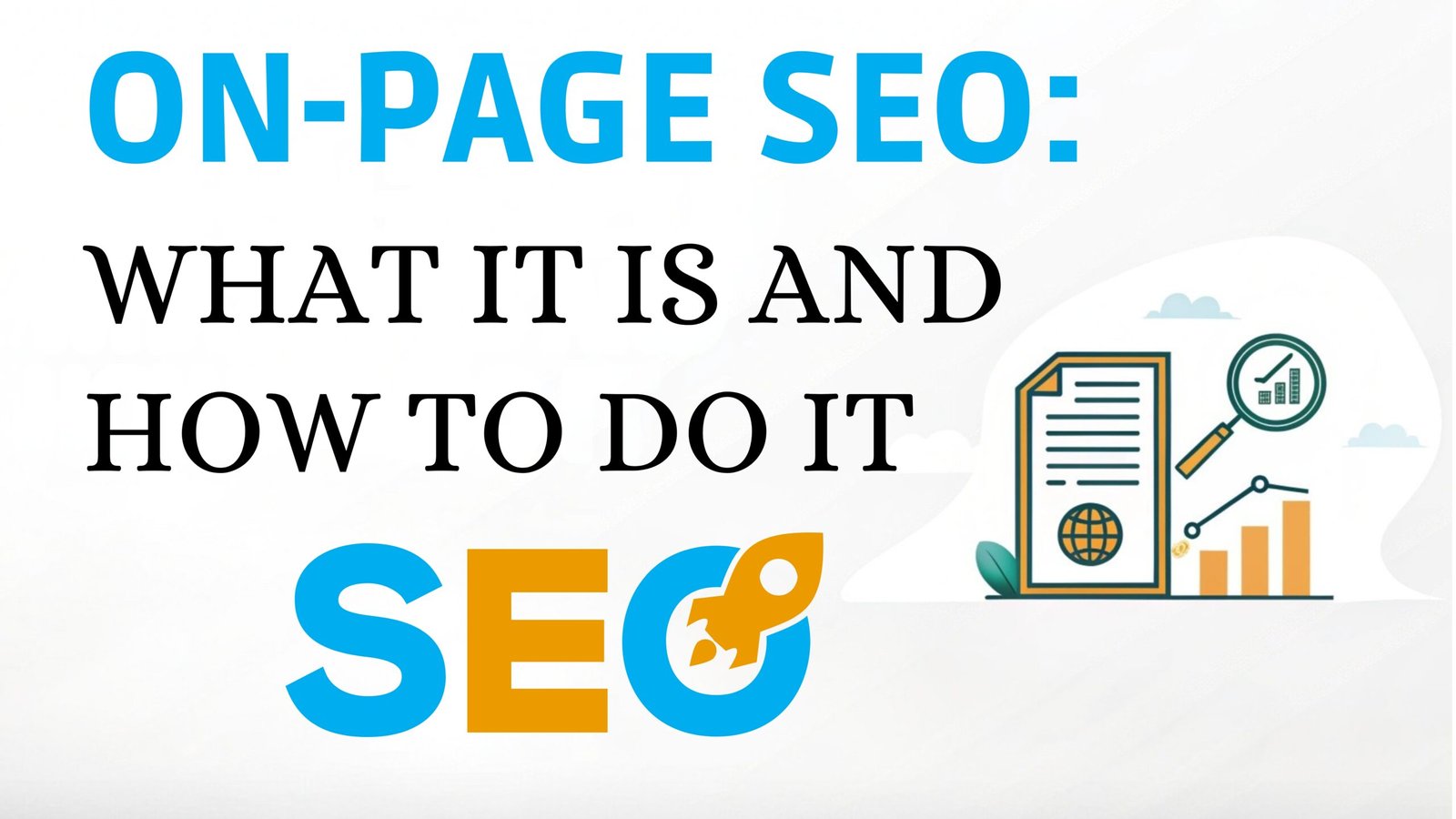In today’s digital world, businesses must focus on their online presence to stay competitive. Whether running a small blog or managing a large e-commerce site, driving organic traffic to your website is crucial. This is where On Page SEO (Search Engine Optimization) comes in, as a bridge between your website and potential customers.
There are two main types of SEO: on-page and off-page SEO. While off-page SEO includes strategies like backlinks and social signals, on page SEO is all about optimizing the individual pages of your website. In this blog, we’ll dive deeply into on page SEO, explain why it’s crucial for your website’s success, and walk you through practical ways to implement it. By the end, you’ll have a solid understanding of how to boost your search engine rankings and improve your site’s visibility.
What Is On Page SEO?
On page SEO refers to optimizing a website’s content, structure, and HTML elements to improve its search engine rankings. Unlike off-page SEO, which involves factors like backlinks, on page SEO focuses on ensuring each page is well-optimized for search engines.
The purpose of on page SEO is to ensure that search engines can easily crawl and understand the content on your site. It also helps ensure your pages match what users are searching for, improving their experience and increasing the chance they will stay on your site longer.
How On Page SEO Works
On page SEO directly impacts various elements of a web page, including:
- Keywords: Choosing the right keywords and integrating them naturally within your content is one of the most critical aspects of on page SEO.
- Content: High-quality, engaging, relevant content is crucial for SEO success. It should answer the searcher’s query comprehensively and offer value.
- HTML Tags: These are elements like title tags, header tags, meta descriptions, and image alt tags that help search engines understand the content of your page.
- URL Structure: A clear, descriptive URL structure makes it easier for users and search engines to navigate and understand your content.
On page SEO works by helping search engines know exactly what each page is about, and it also boosts the relevance and usability of the page for visitors.
Why Is On Page SEO Important?
On page SEO is crucial because it helps search engines understand your content, improving your website’s rankings. It enhances user experience by making pages more accessible, relevant, and faster. Proper on page SEO ensures your website is easily indexed, leading to higher visibility, increased organic traffic, and better engagement.
Impact on Search Engine Rankings
On page SEO is crucial because it directly influences how well your website ranks on search engines. Proper on-page optimization ensures that search engines can index and rank your content appropriately. The better your page is optimized, the higher the chances of appearing at the top of search engine results pages (SERPs).
Improved User Experience
When on page SEO is done correctly, it improves the overall user experience. A well-optimized page loads faster, is easy to navigate, and contains relevant, high-quality content. These factors help your SEO engage visitors and encourage them to explore your site further.
Better Indexability by Search Engine Crawlers
Search engines like Google use bots, also known as crawlers, to scan and index web pages. By optimizing on-page elements such as title tags, meta descriptions, and URLs, you make it easier for these crawlers to understand what your page is about. The easier your site is to crawl, the more likely it is to rank higher.
How to Implement On Page SEO
Now that we understand the importance of on page Search Engine Optimization let’s go through a step-by-step guide on how to implement it effectively.
Step 1: Keyword Research & Optimization
Effective SEO starts with proper keyword research. You need to understand what your audience is searching for. Use tools like Google Keyword Planner, Ubersuggest, or SEMrush to find relevant keywords related to your content.
Once you have a list of target keywords, incorporate them naturally into your content, title tags, headings, and meta descriptions. Avoid keyword stuffing, as it can harm your rankings.
Step 2: Use Tools to Monitor and Improve SEO
SEO is an ongoing process. To track and improve your on page SEO efforts, you’ll need tools that can help you measure performance. Tools like Google Analytics can provide valuable insights into how well your website is performing. Similarly, plugins like Yoast SEO (for WordPress users) can guide you through optimizing each website page.
Step 3: Consistently Apply and Improve On Page SEO
SEO is not a one-time task; it must be continuously monitored and improved. Make it a habit to review your SEO strategy regularly and tweak your content as needed.
Key On Page SEO Factors
Now, let’s explore the critical elements of a strong on page SEO strategy.
1. Keyword Research & Optimization
Choosing the right keywords and optimizing them correctly is one of the most critical factors in on page SEO. Make sure your target keywords are:
- In the title tag, Place your main keyword at the beginning of the title tag.
- In the first 100 words of your content: This helps search engines understand what your page is about.
- In headings and subheadings: Use keywords in header tags (H1, H2) for better structure.
2. Title Tag Optimization
The title tag is one of the first things search engines look at. The clickable headline appears in the search results, so make it catchy and descriptive and include your target keyword. Keep your title tag under 60 characters to ensure it displays correctly in search results.
3. Meta Description
Meta descriptions are short snippets that summarize your page’s content. Although they don’t directly impact rankings, they improve your click-through rate (CTR). Write concise, compelling meta descriptions that include your target keyword and encourage users to click.
Transform Your Digital Presence
Get personalized strategies and solutions tailored to your business needs.
- Free Initial Consultation
- Custom Solution Planning
- Expert Team Support
4. URL Structure
Having clean, descriptive URLs helps search engines and users understand your content. Avoid using long, confusing URLs with unnecessary characters. Instead, use short, keyword-rich URLs that clearly describe the page content.
5. Header Tags (H1, H2, H3)
Header tags structure your content and make it more readable for users. Use H1 for your main title, H2 for significant subsections, and H3 for additional subheadings. Including keywords in these headers also helps with SEO.
6. Internal Linking
Internal linking refers to linking to other pages within your website. It helps improve site navigation, keeps users engaged, and boosts your SEO by distributing page authority across your site.
7. Optimizing Images
Images are essential to any website but can slow down your page if not correctly optimized. Use image compression tools to reduce file sizes and include descriptive alt text with relevant keywords. It helps search engines understand what the image is about.
8. Content Quality & Relevance
High-quality, relevant content is the backbone of on page SEO. Search engines prioritize content that answers user queries thoroughly and accurately. Ensure your content is engaging, informative, and updated regularly.
9. Mobile Optimization
In today’s mobile-first world, ensuring your website is mobile-friendly is crucial. Google also prioritizes mobile-optimized sites in its rankings. Use responsive design and test your site on various devices to ensure a smooth mobile experience.
10. Page Load Speed
A slow-loading page can hurt your rankings and drive users away. Use tools like Google PageSpeed Insights to test and improve page load speed. Some common fixes include image compression, browser caching, and reducing unnecessary JavaScript.
Advanced On Page SEO Tactics
Once you’ve mastered the basics of on page SEO, it’s time to dive into some advanced strategies.
1. Advanced Keyword Research Techniques
Expand your keyword research to include long-tail keywords and semantic SEO. Use tools like LSI Graph to find related terms that can help improve content relevancy.
2. Content Depth & Comprehensiveness
Search engines favour content that is in-depth and answers questions comprehensively. Aim to cover topics thoroughly by including detailed explanations, statistics, and real-life examples.
3. Optimizing for Voice Search
With the rise of voice search, optimizing your content for voice queries is essential. Focus on natural language and conversational keywords.
4. UX/UI Design & SEO
Your website’s design can impact both user experience (UX) and SEO. Ensure your design is clean, intuitive, and provides easy navigation.
5. Content Siloing and Topic Clustering
Organize your content into silos and topic clusters to improve relevance and SEO. This structure helps search engines understand the relationships between your pages.
Implement Proven On Page SEO Techniques
To succeed with on page SEO, you need to:
- Consistently apply the best practices we’ve discussed.
- Use A/B testing to measure the effectiveness of changes.
- Regularly check analytics and performance metrics to make data-driven decisions.
Conclusion
On page SEO is one of the most important aspects of search engine optimization. By optimizing your website’s content, structure, and elements like keywords, title tags, and meta descriptions, you can boost your rankings, improve user experience, and drive organic traffic to your site.
Remember, SEO is a long-term strategy. Consistently applying and refining SEO techniques is key to sustained success. Keep testing, monitoring, and adjusting your plan to stay ahead in the competitive digital landscape.
If you’re looking for professional help, consider working with an SEO agency in Jaipur or SEO services in Jaipur to get expert guidance and optimize your website effectively. By partnering with the right SEO company in Jaipur, you can take your website’s SEO to the next level.





